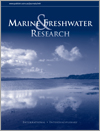Marine and Freshwater Research
Volume 74
Number 14 2023
Juvenile whiting uses intertidal pools in Moreton Bay as a nursery habitat at low tide. To investigate their movement as the tide floods and ebbs, we used funnel-net camera traps set on the upper shore. Smaller juvenile whiting migrates to the upper intertidal by using sand channels, whereas larger juvenile whiting accesses these and other intertidal habitats. Smaller whiting fed preferentially on bottom-dwelling copepods. This information will allow marine park and fisheries managers to protect whiting nurseries in Moreton Bay.
We evaluated the efficacy of a weir on the Mooi River, South Africa, as a fish barrier by using fish surveys. We used species distribution modelling to evaluate the potential for bass to invade the upper reaches. Our surveys detected three bass species. Micropterus dolomieu had the highest invasion potential. There are concerns for both the local trout fishery and native fauna.
This study evaluated growth parameters for common carp found from two different reservoir types (lowland type v. highland type) and compared the results using the multi-model inference method. Larger asymptotic length was detected for all individuals in the lowland type reservoir. Individuals of the same size in lowland type had wider bodies than did those in the highland type.
In this work, those interested in shrimp coexistence mechanisms will be surprised by the results obtained from the use of an interesting tool such as stable isotopes. They will learn about coexistence mechanisms in shrimp that inhabit littoral communities of South American lake in the alluvial valley of Paraná River.
The catch performance of fishing gear depends on species’ behaviour, habitat, fishing grounds, fishing regulations and oceanographic conditions. Besides, to optimise the catch, experienced fishermen mostly use the right gear at the right time and place. Therefore, the fact that baited traps more efficiently target swimming crabs than do other gear types may be due to two critical factors, namely, the habitat of the crabs in the benthic area and the chemoreceptive sensory behaviour of crabs in detecting the bait.
Bryozoans are distributed worldwide and are important reef builders. Methods used to define the age of bryozoan colonies are controversial, especially for species that grow on the continental shelf. In this work, we describe and utilise a new experimental design for measuring the growth of heavily calcified bryozoans in the open ocean, at 56-m depth, using the species Cellaria immersa. The results indicated a slow growth rate compared with other species, and some interesting growth patterns that occur within the colony.





